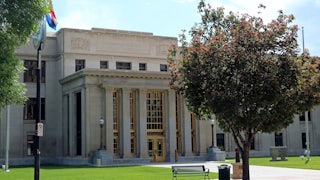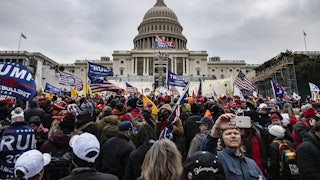The embourgeoisement of organized labor proceeds at a fast clip. Graduate students, adjunct professors, digital journalists, congressional staffers, NGO do-gooders—they all want to join unions, and more power to them. While their college and graduate degrees may exclude them from any conventional definition of “working class,” their anemic paychecks do not. But the professional-managerial class is never going to be the beating heart of a thriving labor movement, because that leaves out workers who lack college degrees, i.e., most of them. It’s necessary and good for the college-educated to seek greater power in the workplace, but boutique unionism can never squeeze more than a few drops of fair pay out of any enterprise that lacks profits to redistribute. The ivory tower, Grub Street, politics, and philanthropy aren’t where the money is—and labor needs to go where the money is. Willie Sutton famously recommended banks.
On Monday, workers at two Wells Fargo branches notified the National Labor Relations Board that they plan to hold elections on whether to organize with the Communications Workers of America, or CWA. One branch is in Bethel, Alaska, the other in Albuquerque, New Mexico; there are 13 nonmanagement workers between the two. The major issues there appear to be low pay and insufficient staffing. The Wells Fargo organizers draw inspiration from efforts to unionize Amazon warehouses and Starbucks coffee shops, and also from the new United Auto Workers contract. Jesse McCool, a compliance officer for Wells Fargo in St. Louis who’s helping to lead the drive, told The Wall Street Journal: “We would be foolish to not strike while the iron is hot.”
The labor share of national income relative to capital has declined sharply in the twenty-first century; even McKinsey says so. Herding capital into labor unions, or anyway the people in charge of capital, is an ingenious way to address this problem. Investment bankers may be too rich to consider unionizing, but the workers at your corner bank bear little resemblance to Mr. Monopoly. According to the Bureau of Labor Statistics, the median salary for a bank teller is $36,380; for a bank manager, $68,976. These are both below median household income ($74,580). Though a bank manager typically gets another $20,000 or so in bonuses, I can well imagine wondering why, after counting so many greenbacks in the course of my workday, I get to take so few home. It’s not, apparently, like working at Gray’s Papaya, where you can eat all the hot dogs you want. Indeed, one in three bank tellers is on some form of public assistance. In capitalist America, capital is on the dole.
Yet only 1.3 percent of banking employees belong to a union, compared to about 6 percent in the entire private sector. “The financial sector is currently the least unionized in the country,” says the CWA, “despite having the largest footprint on the U.S. economy.” That’s a slight exaggeration; insurance has a lower unionization rate (1.2 percent). But I suppose you could argue insurance is part of the financial sector. Anyway, banking’s unionization rate is very low. Restaurant employees, most of whom work in fast food, have a higher unionization rate than bankers. The reason it’s news when two bank branches separated by three thousand miles try to join a union is that it happens so rarely. When 100 workers at Beneficial State Bank, a Los Angeles–based community bank founded by the philanthropist billionaire Tom Steyer, voted to affiliate with CWA last March, it became the first bank to unionize since First American Bank in Willmar, Minnesota, affiliated with the UAW way back in 1983. By one estimate, no more than 30 banks have ever been unionized at any given time, and none of the big ones has ever unionized.
Wells Fargo is one of the big ones. It’s the fourth-largest bank in the United States, with assets of almost $1.7 trillion and more branches (4,600) than any other bank except JP Morgan Chase, the country’s biggest bank. It’s usually a mistake for managers to read a union drive as a sign that the company’s workers don’t love them—Howard Schultz of Starbucks was notoriously susceptible to such self-pity—but in the case of Wells Fargo, CWA started organizing because of the 2016 scandal over workers being pressured to engage in deceptive practices ranging from sleazy to illegal. As of September, management was still struggling to right the ship. Indeed, as recently as December 2022, the Consumer Finance Protection Bureau leveled a $1.7 billion fine, plus $2 billion in customer restitution, on Wells Fargo for assessing fees and interest charges on auto and home loans illegally. “Wells Fargo is a corporate recidivist,” CFPB Director Rohit Chopra said at the time.
In a 2022 letter to shareholders, Wells Fargo chief executive Charles Scharf insisted that “we have a different company today” and that “hubris, contempt and indifference” were no longer acceptable there. “We will listen and not retaliate,” Scharf pledged at a Senate Banking Committee hearing last year, when asked whether he’d interfere with unionization efforts. But even before the Albuquerque and Bethel branches moved to unionize, employees at Wells Fargo branches were filing unfair labor practice charges. Democrat Sherrod Brown, chairman of the Senate Banking Committee, detailed some of these in an October letter to Acting Comptroller of the Currency Michael Hsu and Federal Reserve Vice Chair Michael Barr. Since May, Wells Fargo managers have been charged with either threatening or retaliating against employees engaged in union activity in Salt Lake City; Des Moines, Iowa; San Antonio; Beaverton, Oregon; and Chandler and Lake Havasu, Arizona. The bank settled the Salt Lake City case, and an NLRB regional director ruled against the bank in the Beaverton case.
Yes, we are only talking about 13 bank workers, but every movement starts somewhere. Ten years ago, Barbara and John Ehrenreich—who coined the term “professional-managerial class” in 1977—revisited the subject and found that people with “college and higher degrees have proved to be no more indispensable, as a group, to the American capitalist enterprise than those who honed their skills on assembly lines or in warehouses or foundries.” Frustration with that circumstance is now causing a wide swath of the professional-managerial class to unionize, and banks are an especially ripe target. It’s not hard to imagine the Wells Fargo unionization drive spreading to the better-behaved American banks.
At the 2022 Senate Banking Committee hearing, the chief executives of the six biggest banks in America all pledged, alongside Scharf, never to interfere with union drives, but it was interesting to watch many of them stumble over their words before answering. It goes against their instincts and their likely future behavior. Let the outside agitating begin.






